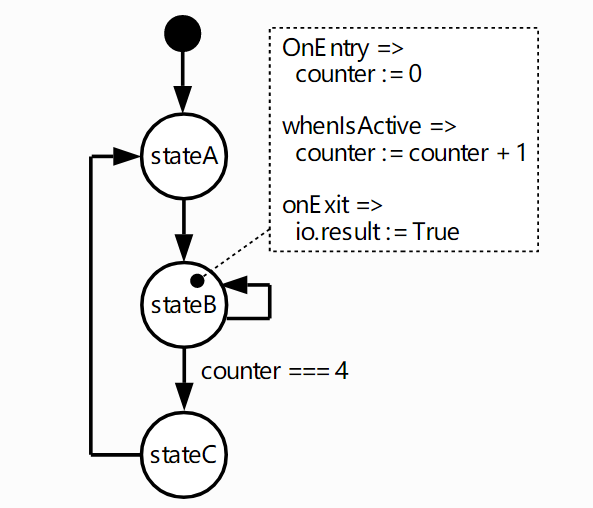-
spinal HDL - 10 - 状态机
状态机
介绍
在 SpinalHDL 中,您可以通过使用枚举和 switch/case 语句来定义您的状态机,就像在 VHDL/Verilog 中一样。但在 SpinalHDL 中,您也可以使用专用语法。
下面的状态机在以下示例中实现:

风格一:
import spinal.lib.fsm._ class TopLevel extends Component { val io = new Bundle { val result = out Bool() } val fsm = new StateMachine { val counter = Reg(UInt(8 bits)) init (0) io.result := False val stateA : State = new State with EntryPoint { whenIsActive(goto(stateB)) } val stateB : State = new State { onEntry(counter := 0) whenIsActive { counter := counter + 1 when(counter === 4) { goto(stateC) } } onExit(io.result := True) } val stateC : State = new State { whenIsActive(goto(stateA)) } } }- 1
- 2
- 3
- 4
- 5
- 6
- 7
- 8
- 9
- 10
- 11
- 12
- 13
- 14
- 15
- 16
- 17
- 18
- 19
- 20
- 21
- 22
- 23
- 24
- 25
- 26
- 27
- 28
- 29
风格二:
import spinal.lib.fsm._ class TopLevel extends Component { val io = new Bundle { val result = out Bool() } val fsm = new StateMachine{ val stateA = new State with EntryPoint val stateB = new State val stateC = new State val counter = Reg(UInt(8 bits)) init (0) io.result := False stateA .whenIsActive(goto(stateB)) stateB .onEntry(counter := 0) .whenIsActive { counter := counter + 1 when(counter === 4) { goto(stateC) } } .onExit(io.result := True) stateC .whenIsActive(goto(stateA)) } }- 1
- 2
- 3
- 4
- 5
- 6
- 7
- 8
- 9
- 10
- 11
- 12
- 13
- 14
- 15
- 16
- 17
- 18
- 19
- 20
- 21
- 22
- 23
- 24
- 25
- 26
- 27
- 28
- 29
- 30
- 31
- 32
状态机
StateMachine是基类。它管理 FSM 的逻辑。val myFsm = new StateMachine { // Definition of states }- 1
- 2
- 3
StateMachine还提供了一些访问器:姓名 返回 描述 isActive(state)BoolTrue当状态机处于给定状态时返回isEntering(state)BoolTrue当状态机进入给定状态时返回入口点
通过扩展 EntryPoint trait,可以将状态定义为状态机的入口点:
val stateA = new State with EntryPoint- 1
或通过使用
setEntry(state):val stateA = new State setEntry(stateA)- 1
- 2
过渡
- 转换由 表示
goto(nextState),它将状态机安排nextState在下一个周期。 exit()安排状态机在下一个周期处于启动状态(或者,在 中StateFsm,退出当前嵌套状态机)。
这两个函数可以在状态定义中使用(见下文)或 using ,它始终适用,优先于状态。
always { yourStatements }``yourStatements状态
可以使用多种状态:
State(基地之一)StateDelayStateFsmStateParallelFsm
它们中的每一个都提供了以下函数来定义与它们关联的逻辑:
姓名 描述 state.onEntry {```你的声明```}yourStatements状态机不在时应用state,将state在下一个周期state.onExit {```你的声明```}yourStatements在状态机处于状态时应用,state并将在下一个周期处于另一个状态state.whenIsActive {```你的声明```}yourStatements当状态机处于statestate.whenIsNext {```你的声明```}yourStatements当状态机将state进入下一个周期时执行(即使它已经在其中)state.隐含在块中:new State
val stateB : State = new State { onEntry(counter := 0) whenIsActive { counter := counter + 1 when(counter === 4) { goto(stateC) } } onExit(io.result := True) }- 1
- 2
- 3
- 4
- 5
- 6
- 7
- 8
- 9
- 10
状态延迟
StateDelay允许创建一个状态,该状态在执行语句之前等待固定数量的周期。使用它的首选方法是:whenCompleted {...}val stateG : State = new StateDelay(cyclesCount=40) { whenCompleted { goto(stateH) } }- 1
- 2
- 3
- 4
- 5
也可以写成一行:
val stateG : State = new StateDelay(40) { whenCompleted(goto(stateH)) }- 1
状态机
StateFsm允许描述包含嵌套状态机的状态。当嵌套状态机完成(退出)时,执行中的语句。whenCompleted { ... }有一个 StateFsm 定义的例子:
// internalFsm is a function defined below val stateC = new StateFsm(fsm=internalFsm()) { whenCompleted { goto(stateD) } } def internalFsm() = new StateMachine { val counter = Reg(UInt(8 bits)) init (0) val stateA : State = new State with EntryPoint { whenIsActive { goto(stateB) } } val stateB : State = new State { onEntry (counter := 0) whenIsActive { when(counter === 4) { exit() } counter := counter + 1 } } }- 1
- 2
- 3
- 4
- 5
- 6
- 7
- 8
- 9
- 10
- 11
- 12
- 13
- 14
- 15
- 16
- 17
- 18
- 19
- 20
- 21
- 22
- 23
- 24
- 25
- 26
在上面的示例中,
exit()使状态机跳转到启动状态(内部隐藏状态)。这通知StateFsm了内部状态机的完成。StateParallelFsm
StateParallelFsm允许处理多个嵌套状态机。当所有嵌套状态机都完成后,执行中的语句。whenCompleted { ... }例子:
val stateD = new StateParallelFsm (internalFsmA(), internalFsmB()) { whenCompleted{ goto(stateE) } }- 1
- 2
- 3
- 4
- 5
进入状态注意事项
上面定义的进入状态的方式使得在复位和第一次时钟采样之间,状态机处于启动状态。只有在第一次时钟采样之后,定义的进入状态才会激活。这允许正确进入入口状态(在 中应用语句
onEntry),并允许嵌套状态机。虽然它很有用,但也可以绕过该功能并直接让状态机引导到用户状态。
为此,请使用makeInstantEntry()而不是定义。该函数返回开机状态,复位后直接激活。
new State -
相关阅读:
zabbix企业微信告警
JavaScript 67 JavaScript HTML DOM 67.12 JavaScript HTML DOM 元素(节点)
揭示抽象的奥秘:抽象类与接口得一可安天下
手把手教你搭建MinIO分布式集群
原神角色数据分析项目说明文档
【无标题】
linux系统部署Elasticsearch集群
Redis学习笔记—常见应用场景—BitMap
当我让文心一言写个代码来庆祝1024程序员节,它写的代码是……
Python OpenCV 人脸识别
- 原文地址:https://blog.csdn.net/weixin_41445387/article/details/126373991
